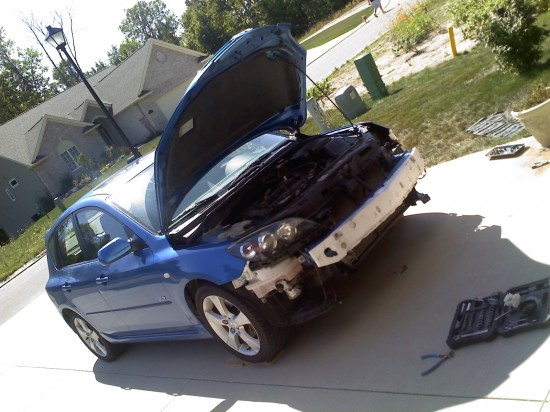Evaluating Your Personal Injury Insurance Claim
Post contributed by Dan Baldyga.
The value of a personal injury claim has a direct relationship to the amount of your medical bills. Why? Because a claim with medical bills of $500.00 is worth three to five times more than a claim with $100.00, or less. And that’s a fact of life in the world of insurance claims.
The adjuster will reason if you were hurt badly enough to run up $500.00 in medical expenses than it’s correct to assume that your injuries must be substantial. But, if you see your chiropractor or physician only once or twice, and your final bills are in the vicinity of $100.00, that adjuster will assume you weren’t hurt too seriously.
DEMAND THAT ALL YOUR MEDICAL BILLS BE PAID: The adjuster may try to disallow a substantial part of your total medical expenses which he contends doesn’t qualify as “medical” in character. He’ll often attempt to divide your medical costs into two arbitrary parts – – “Diagnostic” and “Treatment”. In the “Diagnostic” category he’ll include items such as ambulance and emergency room costs, costs of X-rays, and other diagnostic procedures, plus visits to specialists. And the rest (principally costs of the hospital and regular office visits to doctors, physical therapy and medication) will be termed “Treatment”. The items that are categorized as “Diagnostic” expenses are the bills the adjuster would like to disallow as not being “Medical” types of activities.
He may try to do this because with a differentiation (between what is “Diagnostic” and what is supposedly true medical “Treatment”) the basic worth of your claim will have been drastically reduced, as the amount of your “Special Damages” and thus drastically reduce the true value of your claim. At that point the adjuster will argue that the “Treatment” portion of your medical bills that’s “directly related” to the severity of your injury, therefore it’s what truly reflects (and measures) your “Pain and Suffering”.
Don’t let him get away with that! If he should attempt to pull this on you tell him, “It’s absurd and illogical to separate medical expenses into two arbitrary categories and designate one as “Diagnostic” and the other as “Treatment”. Each area works hand-in-hand with the other in medical practice. I can’t get properly treated without being diagnosed! He’ll gulp, because he knows what you say is true and that will usually be the end of such nonsense on his part.
“PERMANENT” AND/OR “TEMPORARY” DISABILITY: In discussing “Disability”. it’s important to develop a working knowledge of these two legitimate concepts. Commonly, personal injuries are classified as either “Permanent” or “Temporary”. These two terms are used basically to describe the anticipated duration of an injury, and not its degree of severity! Thus, if an injury is conceived as one which would continue throughout the remainder of an individuals lifetime, it’s said to be “Permanent” in nature. Conversely, if it’s a reasonable probably that the claimant will attain a full or complete recovery (within some future period) the injury is classified as “Temporary” – – regardless of how severe or extensive the injury might otherwise appear.
TOTAL AND/OR PARTIAL DISABILITY: Another common classification of “Disabilities” will relate to whether they are considered to be “Total” or “Partial”. These terms refer to the actual extent of the claimant’s injuries, regardless of whether they’re permanent or temporary in duration.
THE FOLLOWING FOUR SPECIAL CATEGORIES ARE REFERRED TO AND UTILIZED IN PERSONAL INJURY LITIGATION
(1) TEMPORARY TOTAL DISABILITY: This is symbolized by a seriously injured person who is temporarily hospitalized or otherwise completely impaired, although expected to eventually regain full function.
(2) TEMPORARY PARTIAL DISABILITY: This is that period when, following the initial period of complete impairment of the seriously injured party (that period of “Temporary Total Disability”), the party recovers and is able to resume some (but not all) formal activities.
(3) PERMANENT TOTAL DISABILITY: This describes a condition (usually applicable in the most sever cases, in which the injury produces a nearly total impairment to the body as a whole) – – again placing the emphasis both on the extent of the functional impairment and its duration.
(4) PERMANENT PARTIAL DISABILITY: This describes a condition where the injured party, (even after sustaining a permanent injury) still retains some substantial body function or earning capacity, with the emphasis centered on the extent of the functional impairment itself.
MEDICAL BILL COVERAGE’S: Read your Motor Vehicle Policy to discover if you have “Medical Payments Coverage”. Also check all your non-automobile insurance policies. You may have coverage(s) to pay your medical bills regardless of who was at fault. If you have a Health Insurance Policy and/or Health Plan of some sort, read the fine print. Your policy may not require you to pay back the medical bill payments made in your behalf – – even if you collect from the person who struck you!
DISCLAIMER: The only purpose of this claim tip is to help people understand the motor vehicle accident claim process. Neither Dan Baldyga nor Automotive Trends make any guarantee of any kind whatsoever; NOR to substitute for a lawyer, an insurance adjuster, or claims consultant, or the like. Where such professional help is desired it is the INDIVIDUAL’S RESPONSIBILITY to obtain said services.
Dan Baldyga’s latest book AUTO ACCIDENT PERSONAL INJURY INSURANCE CLAIM (How To Evaluate And Settle Your Loss) can be found on the internet at his web site http://www.autoaccidentclaims.com. This book reveals “How To” successfully handle your motor vehicle accident claim, so you won’t be taken advantage of. It also goes into detail regarding the revolutionary BASE (The Baldyga Auto Accident Settlement Evaluation Formula). BASE will explain how to determine the value of the “Pain and Suffering” you endured, because of your personal injury.







